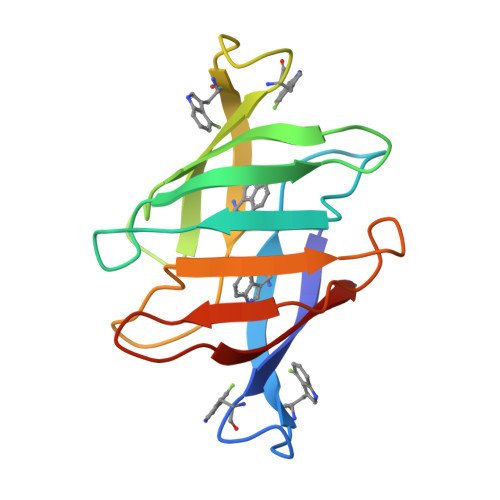Integrating 19 F Distance Restraints for Accurate Protein Structure Determination by Magic Angle Spinning NMR Spectroscopy.
Runge, B.R., Zadorozhnyi, R., Quinn, C.M., Russell, R.W., Lu, M., Antolinez, S., Struppe, J., Schwieters, C.D., Byeon, I.L., Hadden-Perilla, J.A., Gronenborn, A.M., Polenova, T.(2024) J Am Chem Soc 146: 30483-30494
- PubMed: 39440810
- DOI: https://doi.org/10.1021/jacs.4c11373
- Primary Citation of Related Structures:
9AUQ, 9B4V, 9B4W - PubMed Abstract:
Traditional protein structure determination by magic angle spinning (MAS) solid-state NMR spectroscopy primarily relies on interatomic distances up to 8 ?, extracted from 13 C-, 15 N-, and 1 H-based dipolar-based correlation experiments. Here, we show that 19 F fast (60 kHz) MAS NMR spectroscopy can supply additional, longer distances. Using 4F-Trp,U- 13 C, 15 N crystalline Oscillatoria agardhii agglutinin (OAA), we demonstrate that judiciously designed 2D and 3D 19 F-based dipolar correlation experiments such as (H)CF, (H)CHF, and FF can yield interatomic distances in the 8-16 ? range. Incorporation of fluorine-based restraints into structure calculation improved the precision of Trp side chain conformations as well as regions in the protein around the fluorine containing residues, with notable improvements observed for residues in proximity to the Trp pairs (W10/W17 and W77/W84) in the carbohydrate-binding loops, which lacked sufficient long-range 13 C- 13 C distance restraints. Our work highlights the use of fluorine and 19 F fast MAS NMR spectroscopy as a powerful structural biology tool.
Organizational Affiliation:
University of Delaware, Department of Chemistry and Biochemistry, Newark, Delaware 19716, United States.















